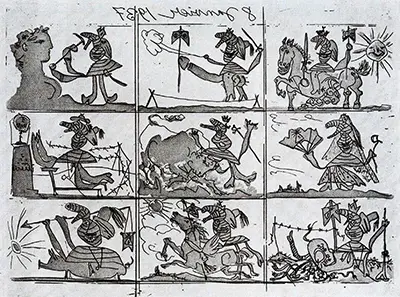The Spanish revolution had begun the previous Summer and, though by now residing in Paris, Picasso became a spokesperson for the Republican Spanish government and accepted the role of Honorary Director-in-exile of the Prado, the highly regarded Madrid museum of art. Prior to the blatant bomb attack on Madrid and the museum itself by Generalisimo Francisco Franco, Picasso had been a quiet supporter of the Republicans and had not mixed his political views with his art. In a bid to offer further support to the Republicans, Picasso produced Dream and Lie of Franco originally to sell in postcard format as propaganda. However, the finished piece of work takes the form of 2 sheets of prints (I and II), each with 9 individual images laid out in a 3x3 format.
The first 14 were completed 8th January 1937, with the last 4 added to the second print 7th June 1937. The works themselves follow a comic book strip style, loosely telling a story. The theme is consistent. The etchings portray Franco as a destroyer of Spanish art, culture and tradition. Images from sheet I include a Franco waving a sword and flag, with Picasso having endowed him with a comically and ridiculously large penis, Franco attacking a classical sculpture with a pick and Franco being gored by a bull, the bull being a representation of the Spanish people.
Print 2 continues in much the same vein, though the last 4 images are directly related to Picasso's piece Guernica, unveiled later in June 1937. Whilst an unusual move at the time for Picasso, Dream and Lie of Franco depicts tragedy through a slightly humorous twist in a bid to appeal to the masses. The prints and prose are powerful and leave the observer in no doubt as to Picasso's musings on the Spanish dictator and his actions. Following Dream and Lies of Franco, Picasso continued to be actively involved in politics for remainder of his life and career, most notably becoming a member of the Communist party and continuing his work as a political activist for peace.


